What happens when two air masses meet?
A front forms, precipitation occurs, and storms form.
What is a maritime tropical air mass?
Maritime tropical air masses originate over the warm waters of the tropics and Gulf of Mexico, where heat and moisture are transferred to the overlying air from the waters below. The northward movement of tropical air masses transports warm moist air into the United States, increasing the potential for precipitation.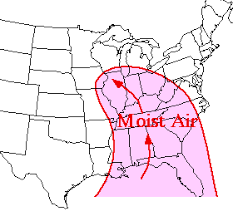
I am a boundary between two air masses where a cooler, denser air mass is actively pushing forward and replacing a warmer air mass, causing a noticeable drop in temperature as the front passes through, often accompanied by clouds and precipitation due to the rising warm air.
What am I?
What is a cold front?
A scientist that studies weather is called this.
What is a meteorologist?
List the four types of precipitation.
Rain, snow, sleet and hail.
When a cold front and warm front meet and the two masses of air are pushing against each other, but neither is powerful enough to move the other. What is this called?
What is a stationary front?
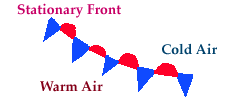
What is a Maritime polar air mass?
This air mass starts very cold and dry but during its long passage over the relatively warm waters of the North Atlantic its temperature rises rapidly and it becomes unstable to a great depth. This air mass is characterised by frequent showers at any time of the year.
I am a weather phenomenon where a mass of warm air pushes into and rises over a cooler air mass, creating a boundary line where the temperature noticeably increases as the warm air advances.
What am I?
What is a warm front?
What is a lake effect?
Where in the US is this most commonly seen?
A "lake effect" refers to a weather phenomenon where cold air moving over a relatively warm and large lake surface picks up moisture, causing it to rise and condense into clouds, resulting in localized areas of precipitation, most commonly heavy snowfall, on the downwind side of the lake, typically occurring when a large temperature difference exists between the air and the water.
This is most commonly seen around the Great Lakes in North America.
What is relative humidity?
Ratio of the amount of water air does hold to the amount of water it can hold at that temperature, typically expressed in percent.
A boundary between two air masses where a cooler, denser air mass is actively pushing forward and replacing a warmer air mass, causing a noticeable drop in temperature as the front passes through, often accompanied by clouds and precipitation due to the rising warm air.
What is a cold front?
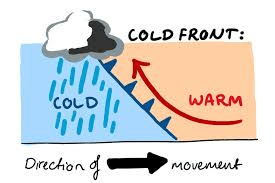
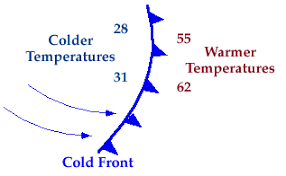
A belt of calm air and sea occurring in both the northern and southern hemispheres between the trade winds and the westerlies in both hemispheres. They are steady winds that blow from east to west near the equator. They are caused by the Coriolis Effect and high pressure.
What are the Horse Latitudes?
What is a stationary front?
and how is the line for the front drawn on weather maps?
A weather front where two air masses meet and stop moving. It occurs when neither air mass is strong enough to push the other away.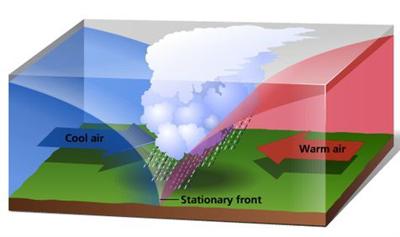
The average weather conditions in a large area over a period of many years - typically 30 years or more.
What is climate?
The temperature at which the water vapor in the air becomes saturated and begins to condense.
What is the dew point?
A weather phenomenon where a mass of warm air pushes into and rises over a cooler air mass, creating a boundary line where the temperature noticeably increases as the warm air advances.
What is a warm front? 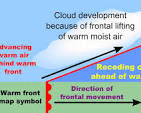
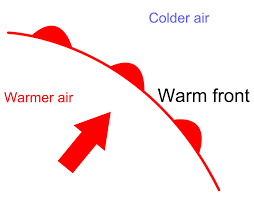
What are the continental tropical air masses?
Continental tropical air masses originate in northern Mexico. Think warm and dry. They are characterized by clear skies and almost no rainfall. If one moves into the Great Plains and stagnates, a severe drought can result.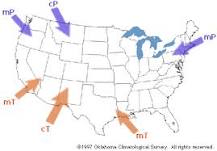
What is an occluded front?
and how is the line for the front drawn on weather maps?
An Occluded Front forms when a warm air mass gets caught between two cold air masses. The warm air mass rises as the cool air masses push and meet in the middle.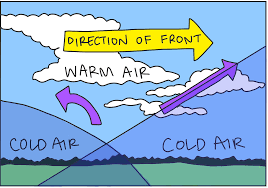
The current or short-term weather conditions in an area. Condition of earth’s atmosphere at a particular time and place.
What is weather?
Prevailing winds that blow from east to west from 30 degrees latitude to the equator in both hemispheres.
What are the Trade Winds?
What are Continental polar air masses?
Continental polar air masses are cold, dry, and stable. These air masses originate over northern Canada and Alaska as a result of radiation cooling.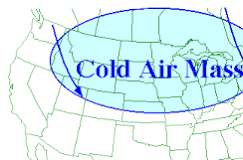
What is an air mass?
An air mass is an immense body of air characterized by similar temperatures and amounts of moisture.
Show how a cold front, a warm front, an occluded front and a stationary front are indicated on a weather map?
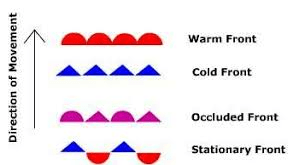
Compare the seasons in the northern and southern hemispheres. Differences?
Which hemisphere has the most harsh winters?
Which hemisphere has the most harsh summers?
The seasons are opposite. When it is winter in the southern hemisphere, it is summer in the northern hemisphere. When it is spring in the southern hemisphere it is fall in the northern hemisphere.
It's the northern hemisphere for both.
This is mainly due to the larger landmass in the North which leads to more extreme temperature fluctuations compared to the ocean-dominant Southern Hemisphere.
What is the apparent deflection of objects moving on or near the Earth's surface called? It's caused by the Earth's rotation on its axis.
What the Coriolis effect?